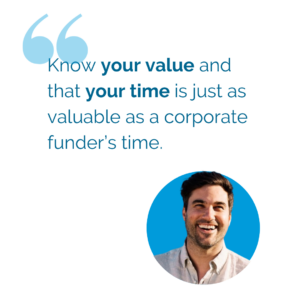We are back with the second in a series of blogs where we “pass the mic” to another member of the multifaceted philanthropic community to gain their personal perspective on issues relevant to the sector and nonprofits. (If you missed our first Q&A, be sure to check out our earlier discussion with Philanthropy for the People’s April Walker.)
This time, I sat down with a fellow Nashvillean, Wade Munday. In January 2023, Wade assumed the role of Bridgestone Americas’ first Director of Corporate Philanthropy and Social Impact, where he is responsible for advancing and directing the strategy and execution of the company’s philanthropic and social programs. He manages the operations of Bridgestone Americas Trust Fund, corporate philanthropy, and workplace giving.
Wade has 15 years of experience working with nonprofits, corporate trusts and government-affiliated organizations. His career in the nonprofit sector began at Children’s Hospital Boston. He was the founding executive director of two smaller nonprofits and the Co-Director of the Addis Clinic, a nonprofit focused on extending access to healthcare in communities throughout Africa. Wade is a graduate of Vanderbilt Divinity School, where he studied under such luminaries as civil rights icon Reverend James Lawson. He credits his time at Vanderbilt with helping to shape his strong social justice orientation.
My conversation below with Wade includes an exploration of his current corporate philanthropy role, guidance for nonprofits seeking institutional funding, and how he has centered Diversity Equity & Inclusion principles in his own work.
Leveraging Bridgestone’s Expertise in Creating Social Impact
Johnisha Levi: Can you share with us a bit about the lead up to creating this new Corporate Philanthropy and Social Impact role at Bridgestone? Before you came, what was the structure for making decisions and awarding support?
 Wade Munday: In the 1980s, Bridgestone, the largest rubber manufacturer in the world, acquired Firestone, along with all of the companies associated with it. And within those companies was a trust fund that was seeded initially with a $1.5 million endowment. The trust fund was originally established to benefit the Akron, Ohio community. With Bridgestone, this was extended to supporting communities around the country. With this change, the decision-making became very diffuse and guided by team members’ and executives’ interests.
Wade Munday: In the 1980s, Bridgestone, the largest rubber manufacturer in the world, acquired Firestone, along with all of the companies associated with it. And within those companies was a trust fund that was seeded initially with a $1.5 million endowment. The trust fund was originally established to benefit the Akron, Ohio community. With Bridgestone, this was extended to supporting communities around the country. With this change, the decision-making became very diffuse and guided by team members’ and executives’ interests.
We were and still remain the largest contributor to the United Way of Greater Nashville. That relationship goes back 30 years, because our CEO at the time was very invested in social services and strengthening the social safety net of Nashville. We have also prioritized investing in athletes with different abilities through Adaptive Sports Ohio because it aligns with our sports partnerships (Bridgetone sponsors both the Olympics and the Paralympics). We have given money to many other nonprofit organizations, but it is fair to say our reach was broad, not deep.
JL: What are your current priorities in your new role?
WM: Going forward, Bridgestone is looking to co-create impact and co-create value with partners in the nonprofit sector that we work with, and deepen those relationships. Through alignment of our business interests and our giving priorities, we will apply Bridgestone’s company ethos— to serve society with quality products, services, and solutions in the mobility space—to the work of creating meaningful change in society.
Specifically, Bridgestone is especially interested in increasing the number of women in the auto tech workforce, which right now is abysmally low. We see supporting organizations such as Play Like a Girl and TechForce Foundation as a means of narrowing this gap.
We’ve started partnership discussions with Play Like A Girl, which in the last twenty years has encouraged girls to be more involved in team sports as a means to engage them in STEM activities and prepare for executive careers, including at corporations such as Bridgestone. This is an organization that focuses on not only young girls, confidence, and mental health, but also diversity in team sports, the classroom, and C-Suite offices throughout the country. We’ll be working with them to enroll girls in Nashville and the Cleveland area (where we have another corporate presence) in mentorship circles with Bridgestone teammates. Likewise, Bridgestone is working with TechForce Foundation, a nonprofit committed to the career exploration and workforce development of professional technicians, on closing the gender gap in the autotech workforce.
Lessons from–and Advice for—the Nonprofit Sector
JL: Tell us about your background in healthy equity and nonprofits and some of the strengths and insights that you feel you bring to the world of corporate philanthropy? How do you think your experiences shaped your conceptions of philanthropy?
WM: I think philanthropy is extremely limited in its ability to address our healthcare system. However, it can be a catalyst for what I think most solutions to our greatest social problems are, which is greater government involvement. Big government, when effective, can achieve significant impact. My own family history is an example of this; when the federal government intervened to bring electricity to the Tennessee Valley, many people were lifted out of poverty.
I think inasmuch as corporate philanthropy can be involved and build relationships with organizations that are engaged in health equity, they can and should also support advocacy work and not shy away from what the actual solutions are, which is that we can’t keep making this piecemeal approach that is doing nothing to really cut costs on our public systems or for individuals. Ultimately we need to find a government solution that is going to be fair and equitable to everyone involved.
JL: What is a piece of advice you can give to nonprofits seeking institutional funding from a corporate partner like Bridgestone ?
 WM: Know your value and that your time is just as valuable as a corporate funder’s time, and it’s not worth trying to change your program to fit the corporate interests, because we do have a corporate interest. We do want to move our business forward, and if that is going to hinder your work as a nonprofit, if that’s going to drain your time as a leader in a nonprofit, then don’t do it. It will be much better to find another partner.
WM: Know your value and that your time is just as valuable as a corporate funder’s time, and it’s not worth trying to change your program to fit the corporate interests, because we do have a corporate interest. We do want to move our business forward, and if that is going to hinder your work as a nonprofit, if that’s going to drain your time as a leader in a nonprofit, then don’t do it. It will be much better to find another partner.
I think as a fundraiser you often look at the field of foundations and you look at their assets, and you think, “ohh this organization has X amount of money, they can definitely spare some money for us.”
But with corporate giving, and many foundations, funding determinations are often driven by answers to questions like, “Where are we contextually relevant? Where do we have expertise and experience?” For instance at Bridgestone, we have scientists and researchers. We have an environment and health department. We’ve got a legal department, and so all these areas where we have valuable experience should be leveraged to further our grantmaking. We’re not just giving money, but we’re also leveraging our talent and skills to go that much further, which means that we can’t give to everyone, but instead we give in a way that is going to leverage our resources. And I think that’s going to make for a better relationship with our nonprofit partners.
Implementing Diversity, Equity, and Inclusion Initiatives
JL: What has centering DEI in your career looked like?
WM: At The Addis Clinic, we worked with state departments and other organizations to deliver telemedicine services in underserved areas in East Africa, refugee camps, and other areas where primary care was not readily available. I was a white male providing direct services to refugee communities. While I recognized that my white privilege conferred certain advantages when it came to fundraising and other aspects of the executive director role, I felt the responsibility to create opportunities for others to lead. As a result, I worked to create a succession plan so that I would be co-director alongside a female healthcare provider.
Prior to the Addis Clinic, I was at Tennessee Justice for Our Neighbors, which provided legal assistance to people seeking asylum and other humanitarian forms of legal relief, and supported victims of violent crimes who needed mental health services and trauma counseling. There, we observed a gross inequity in the number of people of color who were judges and lawyers. In response, we created a six-week summer program to give young BIPOC college students access to judges and lawyers as mentors. We admitted students to the summer program by taking the inverse of what law school currently looks like, which is approximately 3% Latino, 10% African American, and 30% women. It was a refreshing way of looking at entrenched systems of society. I would like to see that in more areas of my work going forward.
Now at Bridgestone Americas, I inherited the current committee that manages the trust fund. Fortunately our leaders were really thoughtful about the composition of the committee, but I think there’s still some work to do in terms of diversity. We want to articulate our commitment to diversity, equity, and inclusion through a simple statement of our values and principles. We want to encourage participation from the next generation of leaders at the company, include more voices from underrepresented groups within the company, and be champions for our employee resource groups. We are democratizing grantmaking within the company through employee matching gifts and empowering employee resource groups to provide unrestricted operating grants to nonprofits.
You can learn more about the Bridgestone Americas Trust Fund here. If you found this conversation thought-provoking, keep your eye on this space for new Elevate Q&As in the coming months.
About the Author:

Johnisha Levi










 Wade Munday:
Wade Munday: WM:
WM: 




